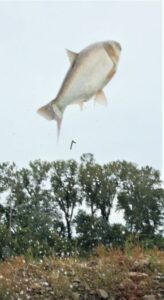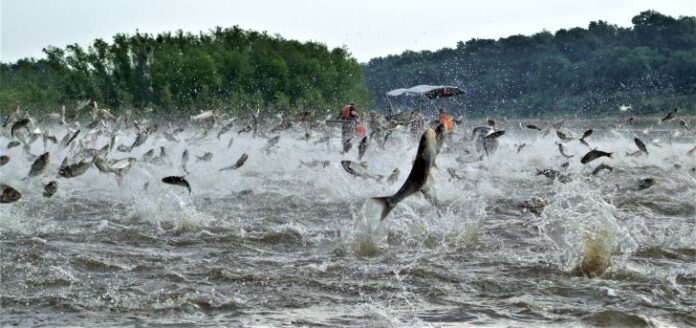By Bo Ljungholm
“Jaws,” the 1970s horror classic, lured record audiences into theaters and sent terrified beach buffs scurrying out of the water. Fortunately, freshwater rivers and lakes offered water-lovers a refuge from any menacing creatures lurking beneath the surface.
Times have changed.
On a clear autumn day in 1994, Marcy Poplett was idling her personal watercraft on the Illinois River and enjoying the gold and auburn leaves along the shore when a silver carp leapt from the water and smacked her between the eyes. Unconscious and bleeding profusely, she fell off the craft and began drifting downstream in the current. She revived just in time to see a towboat headed toward her. The towboat’s horn blasted a warning and a nearby boater rescued Poplett, who suffered multiple injuries including a concussion and a broken nose.
Knocking on the gates
Silver carp belong to a notorious family of fish generally known as Asian carp, and along with their cousin, the bighead carp, they are penetrating further into the country’s freshwater systems and knocking on the gates to the Great Lakes.
Imported from Asia to help control aquatic plants in aquaculture ponds, the fish were accidentally and intentionally introduced to U.S. freshwater rivers and lakes. Prolific breeders and voracious eaters, they out-compete other fish for food and territory and leave an environmental mess in their wake. If they become established in the Great Lakes, they could threaten its $7 billion commercial and sport fishing industry.
Bighead carp have been recorded in at least 18 states and are firmly established in Illinois and Missouri. They can grow to more than 3 feet and reach a scale-tipping 100 pounds. Tales of silver carp attacks are as abundant and large as the fish themselves.
“Big Jim” Hardy owns a bait and tackle shop in Ottawa, Ill., not far from the Illinois River. The fish often jump into his boat, he said, and leave blood and slimy scales. Hardy’s fishing buddy shares the pain and the curse of the carp.
“A 40-pound silver carp hit him right in the face,” Hardy said. “Broke his glasses and knocked out some of his false teeth. Thought he broke his jaw, too. He built a cage around his boat, and now he wears a catcher’s mask when he’s on the river.”
Hardy said the carp started to infest this part of the river system, where the Illinois and Fox rivers meet, about two years ago.
“Now, the rivers are alive with thousands of them,” he said.
Vulnerable site

The steady drumbeat of the Asian carp advance is resonating throughout the country.
One particularly vulnerable site for the carp invasion is the Chicago Sanitary and Ship Canal, part of a series of canals and rivers that link the Mississippi River to Lake Michigan and the rest of the Great Lakes. Electrical barriers about 30 miles from Chicago help keep the upstream portion of the canal free of carp.
But do the electrical barriers guarantee that Asian carp will not invade the Great Lakes?
“No,” said Philip Willink with the Chicago Field Museum, who maintains an informational webpage about Asian carp. He compares the efficiency of the electrical barriers to biologists who use electricity to stun fish for survey collections — a few fish always manage to escape. Studies also indicate that Asian carp navigating toward Lake Michigan could breach the barriers if they swim alongside barges and other vessels that could deflect the electrical current.
Close the locks and dam the canal, say some. Many local and state environmental agencies and organizations are calling for permanent solutions that include filling in portions of the canal system. But this extreme measure would cost billions of dollars in construction and lost revenue from shipping traffic and recreational boating along the canal and river system.
Asian carp have had their day in the highest court of the land. Several Great Lakes states sued the State of Illinois to permanently close the navigational locks leading into Lake Michigan. The U.S. Supreme Court rejected those pleas.
Illinois is President Barack Obama’s home state and Michigan officials accused his administration of favoritism when it supported Illinois in the lawsuit.
But the Obama administration supports other measures to contain these foreign invaders. Its plans include an Asian Carp Control Strategy Framework — and a $51.5 million program-in addition to the $105 million already allocated — to defend the Great Lakes. This multi-faceted strategy includes a list of lethal tactics that reads like a page from a spy novel, including female carp urine to lure unsuspecting males, poison pellets and underwater guns that shoot high-intensity sound waves.
Jackson Gross, a U.S. Geological Survey biologist and lead investigator for one of the projects, said the water guns can shoot a blast of air more than 30 feet to scare or stun fish. If the stun gun proves to be effective, it will used in the Chicago Sanitary Canals to help repel carp.
Like so many other concerned scientists, he laments the loss of native fish in the Illinois River. A century ago, it supported the largest inland fishery in America.
“The Illinois had one of the most diverse fish populations in the country until Asian carp took over,” he said. “Wild carp are like a cancer on the environment.”
Potential weak link
Not far from Chicago lies another potentially weak link that could offer a supply line for the Asian carp attack. Eagle Marsh, a 716-acre wetland preserve just south of Fort Wayne, Ind., lies near a centuries-old trail where French fur trappers once portaged their canoes between the Wabash and Maumee rivers, which link the Mississippi to Lake Erie.
Asian carp in the Wabash might also find this to be a convenient route to the lake if severe floods breach the gap between the rivers. The Environmental Protection Agency (EPA) and the Fish and Wildlife Service funded the installation of an 8-foot-tall chain-link fence the length of nearly four football fields to span the flood-prone area and keep carp from reaching the Maumee. In spite of these efforts, Asian carp imprints have been spotted in Lake Erie and efforts to track and hunt them down have intensified.
Reports of bighead carp in Lake Erie, though few and far between, have surfaced throughout the years from Pelee Island, Sandusky Bay and Cedar Point.
Like evidence at a crime scene, results from water samples collected in late August have brought out the forensic fish experts. A posse of officials from Ohio Department of Natural Resources, Michigan Department of Natural Resources, U.S. Fish and Wildlife Service and U.S. Army Corps of Engineers found silver carp DNA in 20 out of 150 samples taken throughout Sandusky Bay and Sandusky River. Samples from Maumee Bay were negative. Intensive electrofishing and test netting yielded no live Asian carp in any of the areas that were sampled.
Did the criminals escape the dragnet, or was this DNA just a form of circumstantial evidence?
“The breadth of positive samples from the Sandusky Bay area was not expected,” said Michigan Department of Natural Resources Fisheries Chief Jim Dexter. “We need to understand the source of the eDNA (environmental DNA) in order to address it and keep silver and bighead carp from establishing a viable population in the Great Lakes.”
Fish parts and fish DNA can be transported by storm sewers, in bilge water or by fish-eating birds, such as pelicans, that fly long distances.
Inviting habitat
Whatever the mode of transport, Maumee Bay and the Maumee River’s currents, water temperature and abundant food supply offer one of the most inviting habitats in Lake Erie for Asian carp to thrive and reproduce. That doomsday scenario could devastate the most fertile fisheries area in all of the Great Lakes, and the Maumee River’s sport fishing heritage could become a faint memory, like the dilapidated canal locks that lie along its banks.
Commercial fishing could also suffer if Asian carp have their way. Rick Unger, president of the Lake Erie Charter Boat Association, said he thinks that local Department of Natural Resources personnel and other local government agencies are extremely vigilant.
“My concern,” he said, “is at the federal level and not enough being done at the shipping canal in Chicago.”
Federal help is on the way, and the recent introduction of the Stop Invasive Species Act, sponsored by U.S. Sen. Debbie Stabenow, a Michigan Democrat, and Rep. Dave Camp, a Michigan Republican, requires a fast-track plan to defend the Great Lakes’ rivers and tributaries from Asian carp.
Specifically, the bipartisan plan calls for the U.S. Army Corps of Engineers to provide options for stopping Asian carp across 18 possible points of entry into the Great Lakes. Center-stage are the Chicago Waterway System and infrastructure projects that would block Asian carp while allowing shipping to continue along the waterways.
Is there any chance for deliverance from this scaly scourge? Schafer Fisheries in Thomson, Ill., has been harvesting and selling fish since 1955. Now, it annually sells some 10 million pounds of Asian carp worldwide to countries with hearty appetites for what most Americans regard as trash fish. Carp are one of the most popular food fish in the world.
“Problem is that most Americans under 40 won’t buy carp,” said Steve McNitt, general sales manager for Schafer. “They want a boneless white fillet that doesn’t taste like fish.”
Schafer’s retail store features a broad menu of carp products including sausage, hotdogs, jerk and gefilte fish. Asian carp are also processed into a potent and popular brand of fertilizer that is sold across the country. Most of Schafer Fisheries’ revenue comes from Asian carp, and though the commercial harvests may not halt the advance of Asian carp, they do bring one more possible solution to the table.
While new markets are explored and more studies initiated, there will be no truce in the battle for the Great Lakes. The list of foreign villains in the Great Lakes reads like a rogues’ gallery of criminals and killers. Sea lampreys literally sucked the lifeblood out of the Great Lakes fisheries in the 1950s and ’60s; zebra mussels clog municipal water intakes, foul boats and piers and cause millions of dollars in damage; the EPA has identified at least 25 invasive species that disrupt and damage the Great Lakes ecosystem.
Asian carp may appear in that gallery one day, but there is still time to turn the tide and save the Great Lakes from yet another killer.























